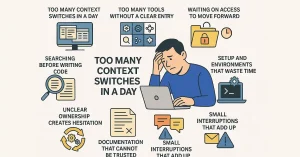What Breaks Developer Flow More Than Bad Code
Most developers do not struggle because the code is hard. They struggle because the work around the code keeps getting in the way. A typical day includes switching tools, searching for answers, waiting on access, and fixing setup issues. By the time a developer starts writing code, focus is already gone. Teams often blame slow […]









